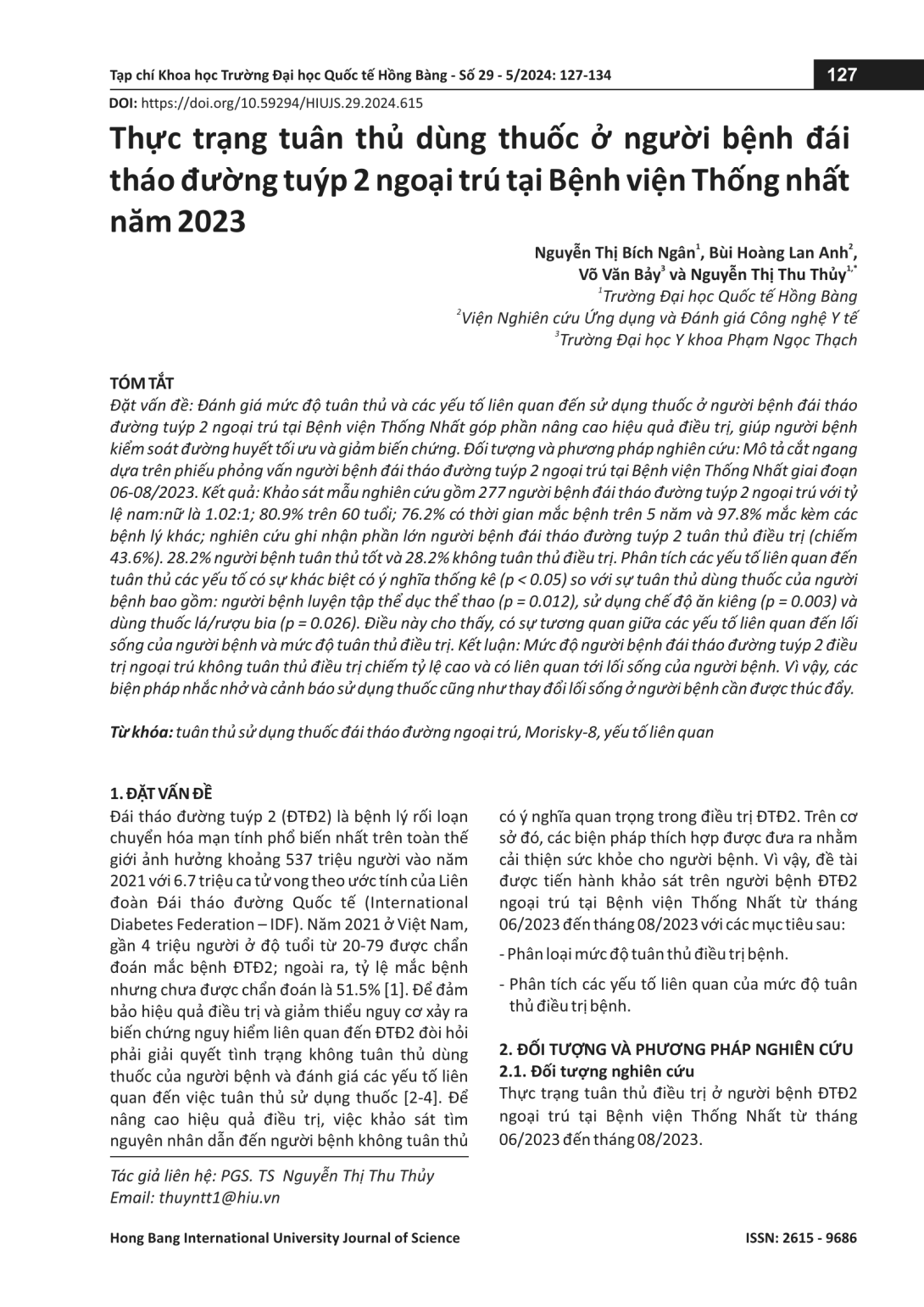
Đánh giá mức độ tuân thủ và các yếu tố liên quan đến sử dụng thuốc ở người bệnh đái tháo đường tuýp 2 ngoại trú tại Bệnh viện Thống Nhất góp phần nâng cao hiệu quả điều trị, giúp người bệnh kiểm soát đường huyết tối ưu và giảm biến chứng. Đối tượng và phương pháp nghiên cứu: Mô tả cắt ngang dựa trên phiếu phỏng vấn người bệnh đái tháo đường tuýp 2 ngoại trú tại Bệnh viện Thống Nhất giai đoạn 06-08/2023. Kết quả: Khảo sát mẫu nghiên cứu gồm 277 người bệnh đái tháo đường tuýp 2 ngoại trú với tỷ lệ nam:nữ là 1.02:1; 80.9% trên 60 tuổi; 76.2% có thời gian mắc bệnh trên 5 năm và 97.8% mắc kèm các bệnh lý khác; nghiên cứu ghi nhận phần lớn người bệnh đái tháo đường tuýp 2 tuân thủ điều trị (chiếm 43.6%). 28.2% người bệnh tuân thủ tốt và 28.2% không tuân thủ điều trị. Phân tích các yếu tố liên quan đến tuân thủ các yếu tố có sự khác biệt có ý nghĩa thống kê (p < 0.05) so với sự tuân thủ dùng thuốc của người bệnh bao gồm: người bệnh luyện tập thể dục thể thao (p = 0.012), sử dụng chế độ ăn kiêng (p = 0.003) và dùng thuốc lá/rượu bia (p = 0.026). Điều này cho thấy, có sự tương quan giữa các yếu tố liên quan đến lối sống của người bệnh và mức độ tuân thủ điều trị. Kết luận: Mức độ người bệnh đái tháo đường tuýp 2 điều trị ngoại trú không tuân thủ điều trị chiếm tỷ lệ cao và có liên quan tới lối sống của người bệnh. Vì vậy, các biện pháp nhắc nhở và cảnh báo sử dụng thuốc cũng như thay đổi lối sống ở người bệnh cần được thúc đẩy.
Assessing the level of compliance and factors related to medication use in outpatients with type 2 diabetes (DM2) at Thong Nhat Hospital contributes to improving treatment effectiveness and helping patients. Optimal blood sugar control and reduced complications. Research subjects and methods: Cross-sectional description based on interview questionnaires for outpatients with diabetes 2 at Thong Nhat Hospital in the period 06-08/2023. Results: The research sample included 277 outpatients with diabetes 2 with a male: female ratio of 1.02:1; 80.9% over 60 years old; 76.2% have a disease duration of over 5 years and 97.8% have other diseases; The study found that the majority of patients with diabetes 2 complied with treatment (accounting for 43.6%). 28.2% of patients complied well and 28.2% did not comply with treatment. Analysis of factors related to compliance factors that have a statistically significant difference (p < 0.05) compared to patient medication compliance include: patients exercising and sports (p = 0.012), diet use (p = 0.003) and tobacco/alcohol use (p = 0.026). Therefore, there is a correlation between factors related to the patient's lifestyle and the level of treatment compliance. Conclusion: The level of non-adherence to treatment in outpatients with type 2 diabetes is high and is related to the patient's lifestyle. Therefore, measures to remind and warn of drug use as well as lifestyle changes in patients need to be promoted.
- Đăng nhập để gửi ý kiến
